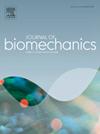基于全髋关节置换术术前运动跟踪和肌肉骨骼建模的运动学-动力学顺应性髋臼杯定位
IF 2.4
3区 医学
Q3 BIOPHYSICS
引用次数: 0
摘要
手术机器人的发明实现了全髋关节置换术(THA)中部件的精确植入。然而,考虑到患者在行走等日常活动中的特定髋关节功能,目前仍缺乏一种术前手术规划方法来确定髋臼杯的对位。为了同时避免假体边缘堆积和撞击,本研究基于术前步态运动学测量和肌肉骨骼建模,建立了一种运动学-动力学顺应性(KKC)髋臼杯定位方法。该方法收集了髋关节周围的计算机断层扫描图像及其步态过程中的生物力学数据,包括运动跟踪和足底反作用力。利用重建的骨盆和股骨几何图形,通过点云注册在下肢肌肉骨骼模型中定位患者特定的髋部肌肉插入点。设计的髋臼杯方向必须在患者特定的安全区域内,以防止植入物撞击,并根据随时间变化的髋关节反作用力选择优化值,以最大限度地降低边缘塌陷的风险。作为对提出的肌肉骨骼模型的验证,七名患者的预测下肢肌肉激活与他们的表面肌电图测量结果相关,计算出的髋关节接触力也与文献数据在数量上一致。然而,设计的髋臼杯方向并不总是在众所周知的卢因内克安全区范围内,这就凸显了根据患者的具体生物力学评估进行 KKC 手术规划的重要性。本文章由计算机程序翻译,如有差异,请以英文原文为准。
Kinematic–kinetic compliant acetabular cup positioning based on preoperative motion tracking and musculoskeletal modeling for total hip arthroplasty
The invention of the surgical robot enabled accurate component implantation during total hip arthroplasty (THA). However, a preoperative surgical planning methodology is still lacking to determine the acetabular cup alignment considering the patient-specific hip functions during daily activities such as walking. To simultaneously avoid implant edgeloading and impingement, this study established a kinematic–kinetic compliant (KKC) acetabular cup positioning method based on preoperative gait kinematics measurement and musculoskeletal modeling. Computed tomography images around the hip joint and their biomechanical data during gait, including motion tracking and foot–ground reaction forces, were collected. Using the reconstructed pelvic and femur geometries, the patient-specific hip muscle insertions were located in the lower limb musculoskeletal model via point cloud registration. The designed cup orientation has to be within the patient-specific safe zone to prevent implant impingement, and the optimized value selected based on the time-dependent hip joint reaction force to minimize the risk of edgeloading. As a validation of the proposed musculoskeletal model, the predicted lower limb muscle activations for seven patients were correlated with their surface electromyographic measurements, and the computed hip contact force was also in quantitative agreement with data from the literature. However, the designed cup orientations were not always within the well-known Lewinnek safe zone, highlighting the importance of KKC surgical planning based on patient-specific biomechanical evaluations.
求助全文
通过发布文献求助,成功后即可免费获取论文全文。
去求助
来源期刊

Journal of biomechanics
生物-工程:生物医学
CiteScore
5.10
自引率
4.20%
发文量
345
审稿时长
1 months
期刊介绍:
The Journal of Biomechanics publishes reports of original and substantial findings using the principles of mechanics to explore biological problems. Analytical, as well as experimental papers may be submitted, and the journal accepts original articles, surveys and perspective articles (usually by Editorial invitation only), book reviews and letters to the Editor. The criteria for acceptance of manuscripts include excellence, novelty, significance, clarity, conciseness and interest to the readership.
Papers published in the journal may cover a wide range of topics in biomechanics, including, but not limited to:
-Fundamental Topics - Biomechanics of the musculoskeletal, cardiovascular, and respiratory systems, mechanics of hard and soft tissues, biofluid mechanics, mechanics of prostheses and implant-tissue interfaces, mechanics of cells.
-Cardiovascular and Respiratory Biomechanics - Mechanics of blood-flow, air-flow, mechanics of the soft tissues, flow-tissue or flow-prosthesis interactions.
-Cell Biomechanics - Biomechanic analyses of cells, membranes and sub-cellular structures; the relationship of the mechanical environment to cell and tissue response.
-Dental Biomechanics - Design and analysis of dental tissues and prostheses, mechanics of chewing.
-Functional Tissue Engineering - The role of biomechanical factors in engineered tissue replacements and regenerative medicine.
-Injury Biomechanics - Mechanics of impact and trauma, dynamics of man-machine interaction.
-Molecular Biomechanics - Mechanical analyses of biomolecules.
-Orthopedic Biomechanics - Mechanics of fracture and fracture fixation, mechanics of implants and implant fixation, mechanics of bones and joints, wear of natural and artificial joints.
-Rehabilitation Biomechanics - Analyses of gait, mechanics of prosthetics and orthotics.
-Sports Biomechanics - Mechanical analyses of sports performance.
 求助内容:
求助内容: 应助结果提醒方式:
应助结果提醒方式:


